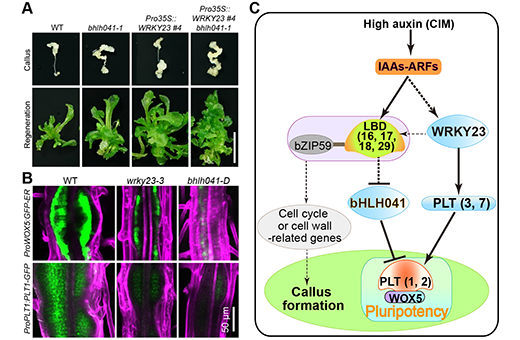
The molecular framework of establishment of regeneration capability of callus cells in plant regeneration
The research team led by Prof. Yuxin Hu from Key Laboratory of Plant Molecular Physiology identified the Arabidopsis WRKY23 and bHLH041 as a respective transcriptional activator and repressor of root stem cell factors during auxin-induced callus formation. They showed that auxin-induced WRKY23 downstream of ARF7/19 directly activates the transcription of PLT3 and PLT7 and thus downstream PLT1, PLT2 and WOX5, and that LBD-induced removal of bHLH041 derepresses the transcription of PLT1, PLT2 and WOX5, respectively. They further provided evidences that transcriptional activation by WRKY23 and derepression by removal of bHLH041 synergize the establishment of callus pluripotency and thus confer shoot-regenerating capability on callus cells.
These findings uncover the transcriptional mechanism underlying establishment of callus pluripotency, which links auxin signaling and cellular reprogramming during auxin-induced callus formation. This work, together with previous studies, outlines the molecular framework of auxin-induced pluripotent callus formation in plant in vitro regeneration programs. In addition, further identification and characterization of WRKY23 and bHLH041 orthologs in crops and economical plants would potentially boost the regeneration-based transgene and gene-editing in these species.
These findings have been published in The Plant Cell in an article entitled "Transcriptional activation by WRKY23 and derepression by removal of bHLH041 coordinately establish callus pluripotency in Arabidopsis regeneration". This work was supported by the National Natural Science Foundation of China (grant no. 31830055 and grant no. 32170317) and the Strategic Priority Research Program of Chinese Academy of Sciences (grant no. XDB27030102).
Articles link: Article: https://academic.oup.com/plcell/advance-article/doi/10.1093/plcell/koad255/7296039?searchresult=1